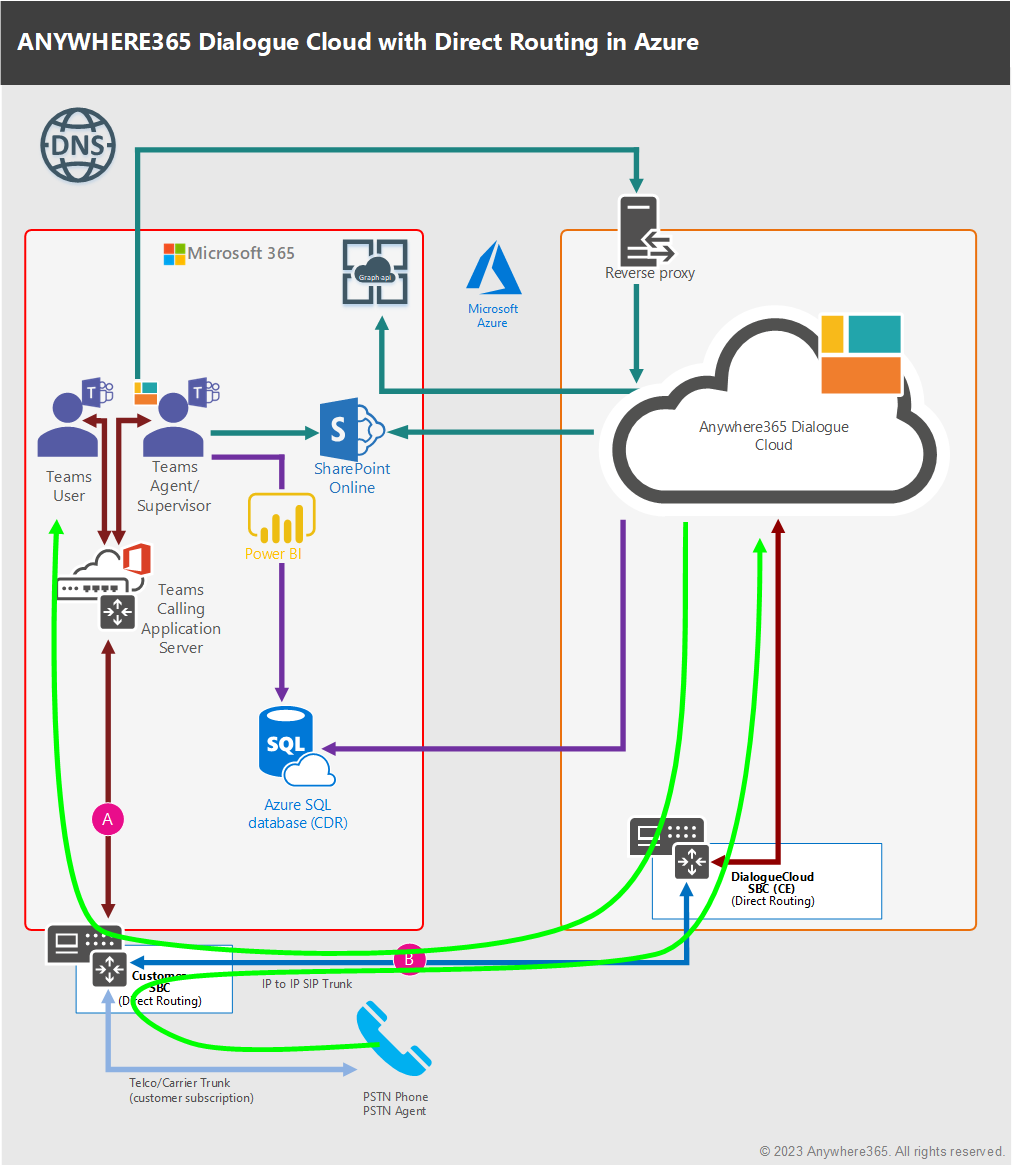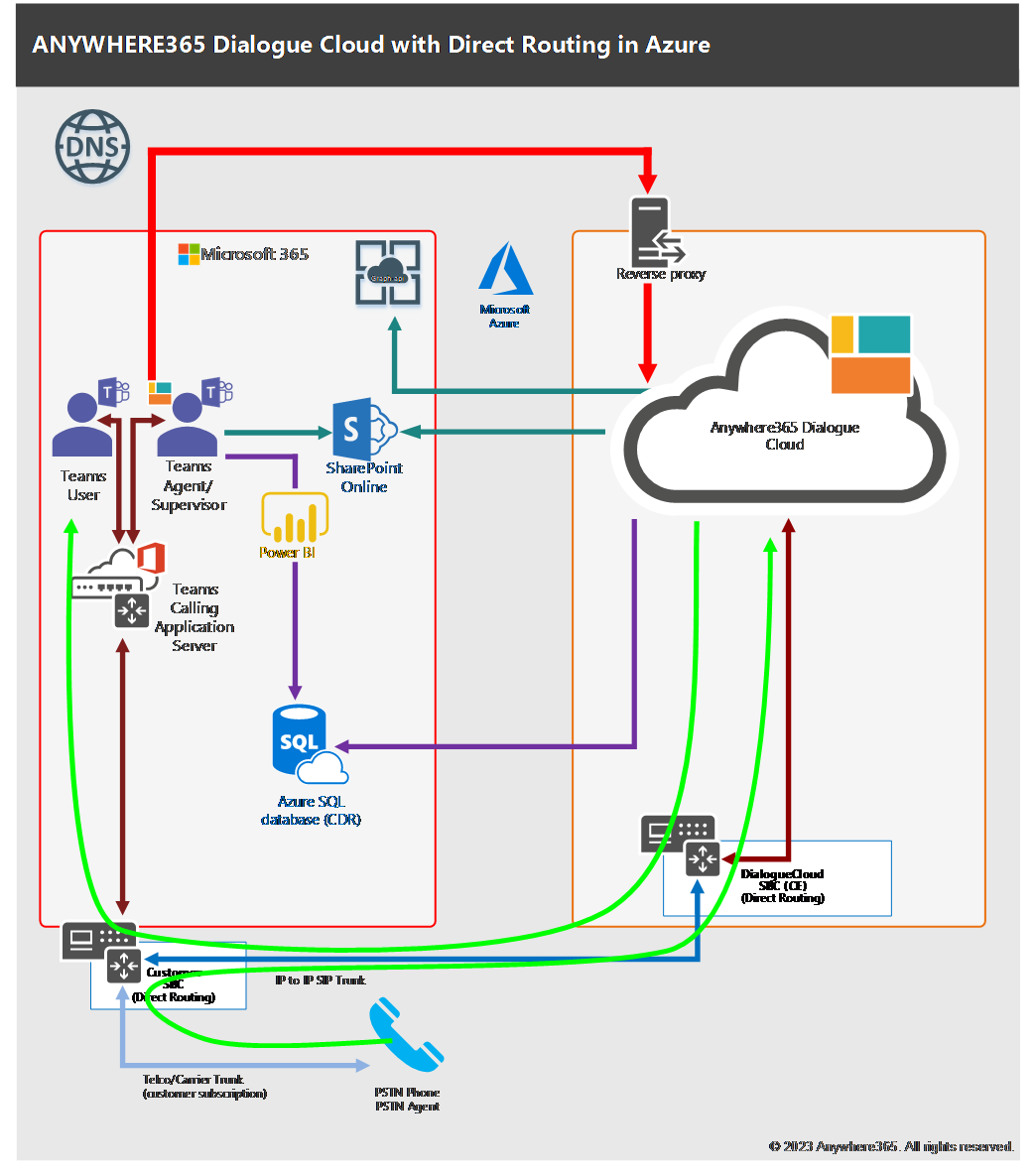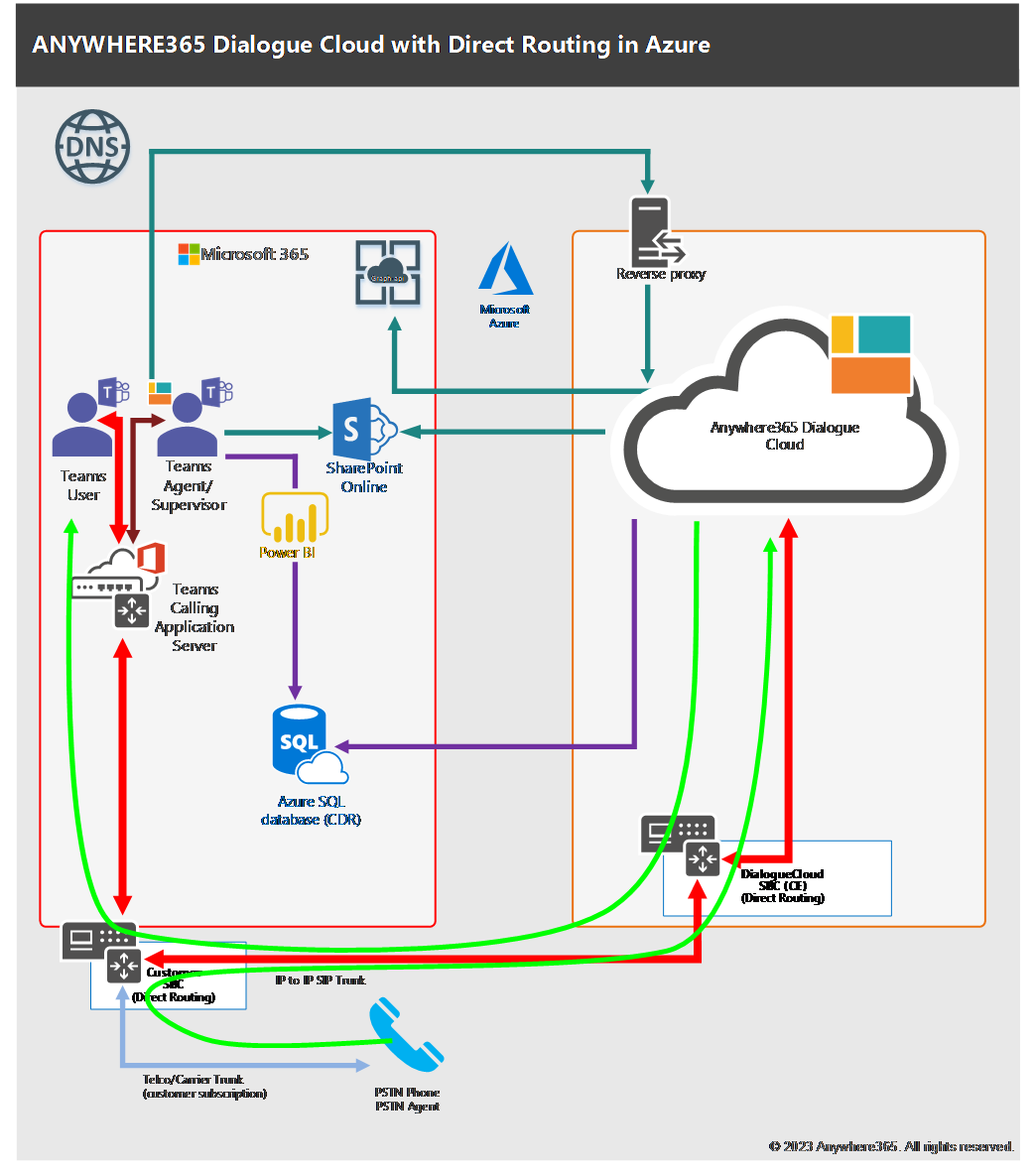2 Dialogue Cloud with Direct Routing
2.1 Introduction
In order to have a successful Voice over IP (VoIP) integration with the AnywhereNow Dialogue Cloud application, it is required that the customer already has a successful integration between the Public Subscriber Telephone Network (PSTN) and the Teams Calling application server.
The phone calls to and from these Teams Calling users will be routed between the Teams Calling VoIP application server and the PSTN using the so called “Teams Direct Route” integration. For this Direct Route the enterprise will have successfully created a path between the PSTN network from their Internet Telephony Service Provider (ITSP) via an enterprise provided SBC to the Teams Calling Application server.
2.2 Dialogue Cloud interconnection model
The Dialogue Cloud Service provides a feature rich calling experience on top of the Teams Calling service to both the calling party and the called party (the agent). To utilize these services, the calls made to PSTN phone numbers serviced by the Dialogue Cloud, must filtered out by the customer’s SBC, and directly forwarded to the Dialogue Cloud SBC instead of the Teams Application server.
After providing the appropriate contact center services to the calling party (i.e., welcome message, voice interaction menu, etc.) the Dialogue Cloud has the option to hunt for a free Contact Center agent. This “hunting” is performed by, based on their Teams presence state, setting up a phone call requests to one or more available Contact Center agent(s) Teams clients.
The routing towards the agent’s Teams client is performed by calling the agent on their personally assigned Teams calling phone number. Where this call is routed from the Dialogue Cloud, via the Anyhere365 SBC and the customer’s SBC towards the Teams Application server. The Teams Application server will forward the call request to the Teams client of the appropriate contact center agent.
The following picture provides a high-level call flow path for a call delivered to the AnywhereNow Dialogue Cloud Contact Center:
Figure 2 – High level interconnection flow
Note:
The picture above provides an example of one of the most common call flows involving Dialogue Cloud services. Depending on the services utilized on the Dialogue Cloud application, the call flow might be different from the example above. For more specifics on the Dialogue Cloud call flows, refer to Chapter 7 Routing Scenarios.
2.3 Contact Center scenarios
2.3.1 Scenario examples
The following list provides an example of the contact Center scenarios are supported within the Dialogue Cloud Direct Routing solution:
- Inbound calls to contact center
- Outbound calls on behalf of contact center
- Blind transfer
- Consultative transfer
- Comfort transfer
- Impersonation
- Interception
- Inbound calls to agent diverted to contact center
- Direct Call Interceptor The Interceptor is a service installed on AnywhereNow. It monitors all calls during set-up on endpoints of active Agents. By intercepting that call set-up and redirecting it to an UCC it lets you manage the direct inbound and outbound dialogues of the contact center agents.
- Outbound calls
- Client forward settings:
- Voicemail
- Number
- Contact
- Call controls
- Hold/resume
- Mute/unmute
- Add participants
- Disconnect
2.3.2 Call control
For a number of the scenarios mentioned above there is a major difference in the call flow and routing depending on how the Contact Center Agent is interacting with the AnywhereNow Direct Cloud application. Possible options for call control by an agent are:
2.3.2.1 Call Control using the WebAgent
When using the WebAgent all call control commands are forwarded over the internet to the AnywhereNow Dialogue Cloud Application and when a call control command is received (e.g. a comfort call transfer), the Application server will coordinate all call handling autonomously.
The red bold lines in the picture below illustrates how a call control command is forwarded from the Contact Center Agent’s WebAgent over the internet to the Dialogue Cloud application server:
Figure 3 – WebAgent initiated call control
It should be noted that from the customer’s SBC perspective the call control for WebAgent initiated request are all handled by the Dialogue Cloud application and therefore additional settings are required in the SBC to support these call cases.
2.3.2.2 Call Control using the agent’s Teams client
Whenever a call is answered by a Contact Center Agent in the Teams Client, the Teams client can also be used to perform actions that influence the call handling of the UCC A Unified Contact Center, or UCC, is a queue of interactions (voice, email, IM, etc.) that are handled by Agents. Each UCC has its own settings, IVR menus and Agents. Agents can belong to one or several UCCs and can have multiple skills (competencies). A UCC can be visualized as a contact center “micro service”. Customers can utilize one UCC (e.g. a global helpdesk), a few UCC’s (e.g. for each department or regional office) or hundreds of UCC’s (e.g. for each bed at a hospital). They are interconnected and can all be managed from one central location. session. Examples of these actions are:
-
Call Hold/Resume
-
Call transfer
-
Consultative call transfer.
The red bold lines in the picture below illustrates how a call control command is forwarded from the Contact Center Agent’s Teams client over the VoIP (SIP The Session Initiation Protocol, or SIP, is a protocol for multimedia communication (audio, video and data communication). SIP is also used for Voice over IP (VoIP). SIP has interactions with other Internet protocols such as HTTP and SMTP.) interface to the Dialogue Cloud application server:
Figure 4 – Teams client initiated call control
Since the Dialogue Cloud application needs to be performed of the actions performed by the Contact Center Agent, information about these call actions must be relayed via the customer’s SBC to the application server. In order to support the relay of these (SIP) messages a number of specific SBC settings are required. For more information about these settings refer to chapter 6.7 Contact Center Agent initiated call transfers .
2.4 Feature interactions with Teams Calling
Please consider that due to service interactions/conflicts some Teams features may function differently or perhaps do not function at all when integrating the AnywhereNow Dialogue Cloud service. Scenarios which are known not to work:
-
Consultative (warm) transfer does not work when the call is transferred to a SIP address of a federated When using AnywhereNow in combination with Federation you can add agents working with a Skype for Business or Teams account to your UCC. contact that utilizes ISLAND mode.
-
Known Defect. Occurrence: Seldom.
-
Teams usually send a reinvite after the call is established to increase the audio codec on the customer side SBC – Teams leg (with or without Media Bypass). As AnywhereNow only uses g711A/U there is no real update via the Re-Invite to the audio channel towards Anywhere as we convert it back to g711A/U. This makes our platform not answer the new offer. Please make sure audio codec preference, restriction or both is also enabled towards Teams. Customer can transcode to SILK if required to Teams, else AnywhereNow recommends stripping unneeded audio codecs towards Teams to make sure Teams will not send a meaningless Re-invite.
-
Known Teams related settings that may need to be changed to ensure proper call flow. Please see chapter 4 Teams Calling configuration Additional Teams configuration for an explanation.
-
Teams voicemail settings
-
Teams music on hold setting
-
Teams busy on busy options
-
Teams simultaneous ring settings
-
Teams forwarding options.


